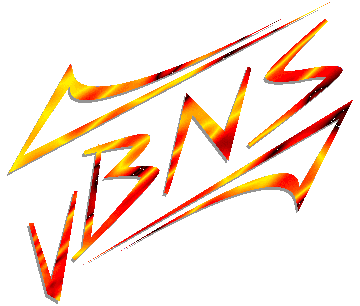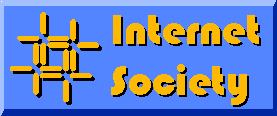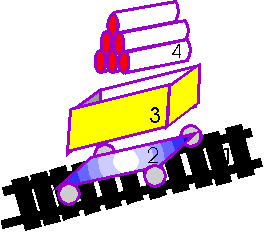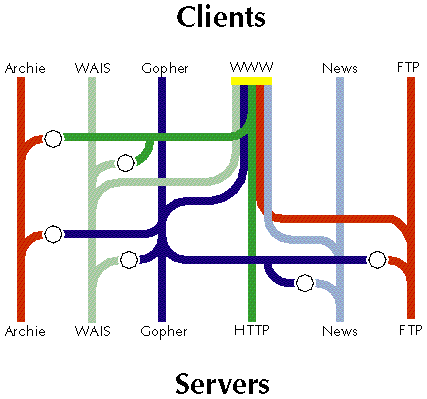



Early 1960s: RAND Corporation charged with development of communication network able to survive and function during and after a nuclear war. No matter how well the wiring itself is protected, it's always vulnerable to impact of atomic bombs. Any central c ommand and control center of such a network would be the first logical target. Obviously, a conventioal network idea would not work.
Paul Baran of RAND published a paper "On Distributed Communications Networks" in 1962-64. The prososal featured a network "designed from the beginning to operate while in tatters."

Pentagon's Advanced Research Projects Agency
(ARPA) [becomes DARPA:
Defence ARPA in 70's], formed in 1956 in response to Sputnik launch by the USSR, decided to implement a decentralized, blastproof, packet-switching network in the USA. The objective was
to develop communication protocols which would allow networked computers to communicate transparently across multiple, linked packet networks. This was called the Internetting project and the system of networks which emerged from the research was known a
s the "Internet." The nodes of the network were to be high-speed supercomputers. First node was installed in 1969 in UCLA. Stanford Research Institute, UCSB and U of Utah soon followed. The netword was named ARPANET, after it's sponsor.
The four computers could transfer data on dedicated high-speed transmission lines. Scientists and researchers could share one another's computer facilities by long-distance. In 1971 there were fifteen nodes in ARPANET; by 1972, thirty-seven nodes.
By the second year of operation, however, an odd fact became clear. ARPANET's users had warped the computer-sharing network into a dedicated, high-speed, federally subsidized electronic post-office. The main traffic on ARPANET was not long-distance c omputing. Instead, it was news and personal messages. Researchers were using ARPANET to collaborate on projects, to trade notes on work, and eventually, to downright gossip and schmooze. People had their own personal user accounts on the ARPANET co mputers, and their own personal addresses for electronic mail. Not only were they using ARPANET for person-to-person communication, but they were very enthusiastic about this particular service -- far more enthusiastic than they were about long-distance computation.
Soon a first mailing list was invented - a mechanism in which an identical message could be sent automatically to large numbers of network subscribers. Interestingly, one of the first really big mailing-lists was "SF-LOVERS," for science fiction fans. Discussing science fiction on the network was not work-related and was frowned upon by many ARPANET computer administrators, but this didn't stop it from happening.
Throughout the '70s, ARPA's network grew. In 1971 ARPANET consisted of 15 nodes (23 hosts): UCLA, SRI, UCSB, U of Utah, BBN, MIT, RAND, SDC, Harvard, Lincoln Lab, Stanford, UIU(C), CWRU, CMU, and NASA/Ames.
Its decentralized structure made expansion easy. Unlike standard corporate computer networks, the ARPA network could accommodate many different kinds of machine. As long as individual machines could speak the packet-switching lingua franca of the new, anarchic network, their brand-names, and their content, and even their ownership, were irrelevant.

1973
 First international connections to ARPANET: England nad Norway.
First international connections to ARPANET: England nad Norway.
1976
 UUCP (Unix-to-Unix CoPy) developed at AT&T Bell Labs and distributed with UNIX one year later.
UUCP (Unix-to-Unix CoPy) developed at AT&T Bell Labs and distributed with UNIX one year later.
1979
Meeting between U of Wisconsin, DARPA, NSF, and computer scientists from many universities to establish a Computer Science Department research computer network.
 USENET established using uucp between Duke and UNC by Tom Truscott and Steve Bellovin.
USENET established using uucp between Duke and UNC by Tom Truscott and Steve Bellovin.
1981
 BITNET, the "Because Its Time NETwork"
BITNET, the "Because Its Time NETwork"
CSNET (Computer Science NETwork) built by UCAR and BBN through seed money granted by NSF to provide networking services (specially email) to university scientists with no access to ARPANET. CSNET later becomes known as the Computer and Science Network.
Minitel (Teletel) is deployed across France by French Telecom.
1982
 The ARPA's original standard for communication was known as NCP, "Network Control Protocol," but as time passed and the technique advanced, NCP was superceded by a higher-level, more sophisticated standard known as TCP/IP, d
etailsofthe design of which were specified in the paper by Vint Cerf and Bob Kahn "A Protocol for Packet Network Internetworking" in 1974. TCP, or "Transmission Control Protocol," converts messages into streams of packets at the source, then reassembles
them back into messages at the destination. IP, or "Internet Protocol," handles the addressing, seeing to it that packets are routed across multiple nodes and even across multiple networks with multiple standards -- not only ARPA's pioneering NCP standa
rd, but others like Ethernet, FDDI, and X.25.
The ARPA's original standard for communication was known as NCP, "Network Control Protocol," but as time passed and the technique advanced, NCP was superceded by a higher-level, more sophisticated standard known as TCP/IP, d
etailsofthe design of which were specified in the paper by Vint Cerf and Bob Kahn "A Protocol for Packet Network Internetworking" in 1974. TCP, or "Transmission Control Protocol," converts messages into streams of packets at the source, then reassembles
them back into messages at the destination. IP, or "Internet Protocol," handles the addressing, seeing to it that packets are routed across multiple nodes and even across multiple networks with multiple standards -- not only ARPA's pioneering NCP standa
rd, but others like Ethernet, FDDI, and X.25.
 InterNetworking Working Group (INWG), created in 1972, establishes the Transmission Control Protocol (TCP) and Internet Protocol (IP), as the protocol suite, commonly known as TCP/IP, for ARPANET.
InterNetworking Working Group (INWG), created in 1972, establishes the Transmission Control Protocol (TCP) and Internet Protocol (IP), as the protocol suite, commonly known as TCP/IP, for ARPANET.
EUnet (European UNIX Network) is created by EUUG to provide email and USENET services.
1983
 Name server developed at U of Wisconsin, no longer requiring users to know the exact path to other systems.
Name server developed at U of Wisconsin, no longer requiring users to know the exact path to other systems.
 Cutover from NCP to TCP/IP (1 January)
Cutover from NCP to TCP/IP (1 January)
CSNET / ARPANET gateway put in place
ARPANET split into ARPANET and MILNET; the latter became integrated with the Defense Data Network created the previous year.
 Desktop workstations come into being, many with Berkeley UNIX which includes IP networking software.
Desktop workstations come into being, many with Berkeley UNIX which includes IP networking software.
Need switches from having a single, large time sharing computer connected to Internet per site, to connection of an entire local network.
Berkeley releases 4.2BSD incorporating TCP/IP
EARN (European Academic and Research Network) established.
FidoNet developed by Tom Jennings.
1984
 Domain Name Server (DNS) introduced.
Domain Name Server (DNS) introduced.
# of hosts breaks 1,000
JUNET (Japan Unix Network) established using UUCP.
JANET (Joint Academic Network) established in the UK using the Coloured Book protocols.
1986

In 1984 the National Science Foundation got into the act, through its Office of Advanced Scientific Computing. The new NSFNET set a blistering pace for technical advancement, linking newer, faster, shinier supercomputers, through thicker, faster links, up
graded and expanded, again and again, in 1986, 1988, 1990. NSFNET today provides a major backbone communication service for the Internet. With its 45 megabit per second facilities, the NSFNET carries on the order of 12 billion packets per month between th
e networks it links. The National Aeronautics and Space Administration (NASA), the National Institutes of Health, and the U.S. Department of Energy contributed additional backbone facilities such as the NSINET and ESNET.
 NSFNET created (backbone speed of 56Kbps)
NSFNET created (backbone speed of 56Kbps)
Cleveland Freenet (start of NPTN) comes on-line.
Network News Transfer Protocl (NNTP) designed to enhance Usenet news performance over TCP/IP.
Mail Exchanger (MX) records developed by Craig Partridge allowing non-IP network hosts to have domain addresses.
1987
 NSF signs a cooperative agreement to manage the NSFNET backbone with Merit Network, Inc. (IBM and MCI involvement was through an agreement with Merit). Merit, IBM, and MCI later founded ANS.
NSF signs a cooperative agreement to manage the NSFNET backbone with Merit Network, Inc. (IBM and MCI involvement was through an agreement with Merit). Merit, IBM, and MCI later founded ANS.

Merit Network, Inc. is a non-profit corporation which is owned by 11 public universities in Michigan. It was formed 25 years ago by the University of Michigan, Michigan State University, and Wayne State University. Merit staff are administratively hosted by the University of Michigan in Ann Arbor.Merit's main purpose has always been to provide network connectivity for the state's higher education community. Originally, this meant connecting academic mainframe computers together so that users at different universities could access each others compu ters, data files could be shared, and printed output could be electronically submitted. More recently, Merit has operated MichNet, an IP backbone network interconnected at 45 Mbps to the rest of the Internet. Merit is the largest Internet service provider in Michigan with connections provided to over 200 organizations including businesses, health care organizations, state go vernment, and educational institutions.
Merit is also involved in many other networking activities, most notably as the lead partner since 1987 on the NSFNET Cooperative Agreement between the National Science Foundation, Merit, ANS, IBM, MCI, and the State of Michigan. Currently, Merit has cont racts with the NSF for routing database work associated with the new Internet Network Attachment Points, with the FAA for routing protocol work, with the Society of Manufacturing Engineers on a TRP-funded projecct to train small businesses in the use of t he Internet, and with the Corporation for Research and Educational Networking (CREN) for BITNET III.
UUNET is founded with Usenix funds to provide commercial UUCP and Usenet access.
# of hosts breaks 10,000
# of BITNET hosts breaks 1,000
1989
# of hosts breaks 100,000
NSFNET backbone upgraded to T1 (1.544Mbps)
RIPE (Reseaux IP Europeens) formed (by European service providers) to ensure the necessary administrative and technical coordination to allow the operation of the pan-European IP Network.
 First relay between a commercial electronic mail carrier (Compurserve) and the Internet through Ohio State University.
First relay between a commercial electronic mail carrier (Compurserve) and the Internet through Ohio State University.
1990
ARPANET ceases to exist.
 Second relay between a commercial electronic mail carrier (MCI Mail) and the Internet through the Corporation for the National Research Initiative (CNRI)
Second relay between a commercial electronic mail carrier (MCI Mail) and the Internet through the Corporation for the National Research Initiative (CNRI)
Electronic Frontier Foundation is founded by Mitch Kapor
1991
Commercial Internet eXchange (CIX) Association, Inc. formed by General Atomics (CERFnet), Performance Systems International, Inc. (PSInet), and UUNET Technologies, Inc. (AlterNet)
 WAIS released by Thinking Machines Corporation
WAIS released by Thinking Machines Corporation
 Gopher released by University of Minnesota
Gopher released by University of Minnesota
US High Performance Computing Act (Gore 1) establishes the National Research and Education Network (NREN)
1992
 Internet Society is chartered
Internet Society is chartered
 World-Wide Web released by CERN
World-Wide Web released by CERN
 # of hosts breaks 1,000,000
# of hosts breaks 1,000,000

 NSFNET backbone upgraded to T3 (44.736Mbps)
NSFNET backbone upgraded to T3 (44.736Mbps)
 First MBONE audio multicast (March) and video multicast (November)
First MBONE audio multicast (March) and video multicast (November)
1993

 InterNIC created by NSF to provide specific Internet services:
InterNIC created by NSF to provide specific Internet services:
 US White House comes on-line:
US White House comes on-line:
 United Nations and World Bank come on-line
United Nations and World Bank come on-line
US National Information Infrastructure Act
Businesses and media really take notice of the Internet
 Mosaic takes the Internet by storm; WWW proliferates at a 341,634% annual growth rate of service traffic. Gopher's growth is 997%.
Mosaic takes the Internet by storm; WWW proliferates at a 341,634% annual growth rate of service traffic. Gopher's growth is 997%.
1994
Communities begin to be wired up directly to the Internet
US Senate and House provide information servers
First flower shop taking orders via the Internet
Shopping malls arrive on the Internet
Mass marketing finds its way to the Internet with mass e-mailings
FUTURE

 The Network: See how the vBNS has combined advanced switching and fiber optic technologies, know as Asynchronous Transer Mode (ATM) and Synchronous Optical Network (SONET) with the Internet Protocol (IP). The vBNS will initially run at 155 Mbps, and in 19
96 MCI will increase network speeds to 622 Mbps.
The Network: See how the vBNS has combined advanced switching and fiber optic technologies, know as Asynchronous Transer Mode (ATM) and Synchronous Optical Network (SONET) with the Internet Protocol (IP). The vBNS will initially run at 155 Mbps, and in 19
96 MCI will increase network speeds to 622 Mbps.

As of 1 Feb 1995, the Internet consisted of more than 50,000 networks in 90 countries. Gateways that allow at least Email connectivity extend this reach to 160 countries. At the end of 1994, 5 million computers were indicated as actually reachable - with an estimated total of 20-40 million users. Network growth continues at around 10 percent per month.

The Internet's "anarchy" may seem strange or even unnatural, but it makes a certain deep and basic sense. It's rather like the "anarchy" of the English language. Nobody rents English, and nobody owns English. As an English-speaking person, it's up to you to learn how to speak English properly and make whatever use you please of it (though the government provides certain subsidies to help you learn to read and write a bit). Otherwise, everybody just sort of pitches in, and somehow the thing evolves on its own, and somehow turns out workable. And interesting. Fascinating, even. Though a lot of people earn their living from using and exploiting and teaching English, "English" as an institution is public property, a public good. Much the same g oes for the Internet. Would English be improved if the "The English Language, Inc." had a board of directors and a chief executive officer, or a President and a Congress? There'd probably be a lot fewer new words in English, and a lot fewer new idea s.People on the Internet feel much the same way about their own institution. It's an institution that resists institutionalization. The Internet belongs to everyone and no one.

Its specific goals and purposes include:
The Internet Engineering Task Force (IETF) is the protocol engineering and development arm of the Internet. The IETF is a large open international community of network designers, operators, vendors, and researchers concerned with the evolution of the Inte rnet architecture and the smooth operation of the Internet. It is open to any interested individual. The actual technical work of the IETF is done in its working groups, which are organized by topic into several areas (e.g., routing, network management, security, etc.). Much of the work is handled via mailing lists, however, the IETF also holds meetings three times per year.
The 1st IETF meeting was held in January, 1986 at Linkabit in San Diego with 15 attendees. The 4th IETF, held at SRI in Menlo Park in October, 1986, was the first at which non-government vendors attended. The concept of working groups was introduced at the 5th IETF meeting at the NASA Ames Research Center in California in February, 1987. The 7th IETF, held at MITRE in McLean, Virginia in July, 1987, was the first meeting with over 100 attendees.




| host access where end-users connect their computers to become part of the Internet, or | terminal access where end users connect to a host computer which is directly connected to the Internet, or | network access where a network of computers become a part of the Internet, or | gateway access where another kinds of computer networks, on-line services, or email services are indirectly interconnected. |
Types of Access
Telephone Service Grades
Other Means of Communications
Coming Technologies



I prefer to think of the Internet services a little differently. We'll look at a "main" service and a "navigational enhancement" to it. Sometimes, the service lends itself to implementation of navigational enhancements to it (WWW and various WWW search en gines); but more often, the "navigational enhancement" grows into a service of its own (FTP and Archie, Gopher and Veronica).
E-Mail address, in addition to the address of a computer, has to specify the name of a particular user. That's done in a folloing way: user@computer.